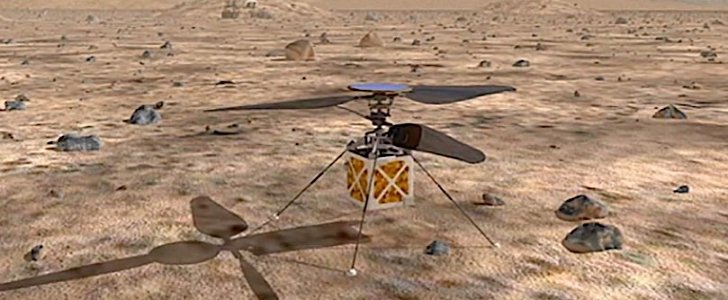In 2020, an Atlas V 541 rocket will lift off from Earth, carrying onboard the next rover that will roam the sand of the Martian planes. This weekend, NASA announced that another machine would be boarding the mission as well.
As a testimony to the fact that the plans for a Martian settlement are as real as they get, the American space agency will try to see whether the Red Planet’s atmosphere is thick enough to support heavier-than-air vehicles flight.
To that end, a so-called Mars Helicopter, a small, autonomous rotorcraft, will be deployed on the surface of the neighboring planet.
Although this is the first time the agency announced such plans, work on the machine started at the Jet Propulsion Laboratory back in 2013. After five years of development, the team of rocket scientists came up with a four pounds helicopter (1.8 kg), with a fuselage about the size of a softball and equipped with twin, counter-rotating blades that will spin at 3,000 rpm.
The speed of the rotors is about ten times faster than the one seen on Earthly helicopters. In theory, this would help it stay aloft in the atmosphere that is only 1 percent that of Earth, or the equivalent of our planet’s atmosphere at an altitude of 100,000 feet (30 km).
The helicopter will be remotely flown from Earth, as soon as its batteries charge, on a 30-day flight test campaign that will include flight distances of up to a few hundred meters and durations as long as 90 seconds.
The first flight will see the helicopter climb only 10 feet (3 meters) into the air, where it will stay for just 30 seconds.
While in the air, the drone will be used to conduct geological assessments, determine the habitability of the environment, search for signs of ancient Martian life, and assess natural resources and hazards for future manned missions.
NASA says this mission is a high-risk, high-reward one. If it doesn’t work, no harm will come to the rover’s assignment. But if it does, NASA plans to use more of them as low-flying scouts and aerial vehicles to access locations not reachable by ground travel.
To that end, a so-called Mars Helicopter, a small, autonomous rotorcraft, will be deployed on the surface of the neighboring planet.
Although this is the first time the agency announced such plans, work on the machine started at the Jet Propulsion Laboratory back in 2013. After five years of development, the team of rocket scientists came up with a four pounds helicopter (1.8 kg), with a fuselage about the size of a softball and equipped with twin, counter-rotating blades that will spin at 3,000 rpm.
The speed of the rotors is about ten times faster than the one seen on Earthly helicopters. In theory, this would help it stay aloft in the atmosphere that is only 1 percent that of Earth, or the equivalent of our planet’s atmosphere at an altitude of 100,000 feet (30 km).
The helicopter will be remotely flown from Earth, as soon as its batteries charge, on a 30-day flight test campaign that will include flight distances of up to a few hundred meters and durations as long as 90 seconds.
The first flight will see the helicopter climb only 10 feet (3 meters) into the air, where it will stay for just 30 seconds.
While in the air, the drone will be used to conduct geological assessments, determine the habitability of the environment, search for signs of ancient Martian life, and assess natural resources and hazards for future manned missions.
NASA says this mission is a high-risk, high-reward one. If it doesn’t work, no harm will come to the rover’s assignment. But if it does, NASA plans to use more of them as low-flying scouts and aerial vehicles to access locations not reachable by ground travel.

